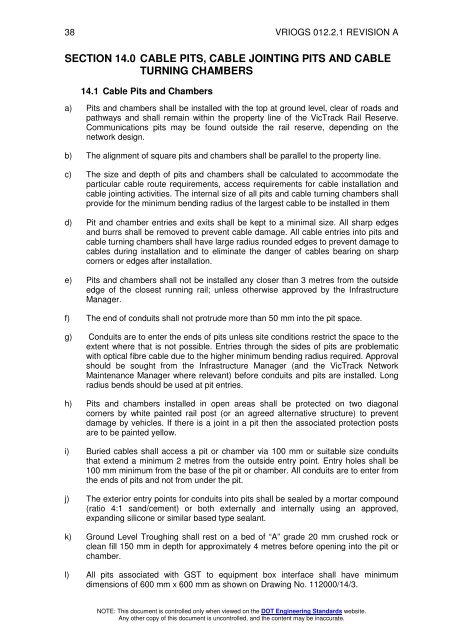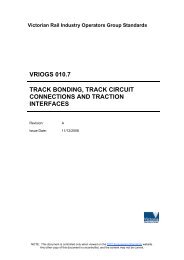VRIOGS 012.2.1 - Public Transport Victoria
VRIOGS 012.2.1 - Public Transport Victoria
VRIOGS 012.2.1 - Public Transport Victoria
You also want an ePaper? Increase the reach of your titles
YUMPU automatically turns print PDFs into web optimized ePapers that Google loves.
38 <strong>VRIOGS</strong> <strong>012.2.1</strong> REVISION A<br />
SECTION 14.0 CABLE PITS, CABLE JOINTING PITS AND CABLE<br />
TURNING CHAMBERS<br />
14.1 Cable Pits and Chambers<br />
a) Pits and chambers shall be installed with the top at ground level, clear of roads and<br />
pathways and shall remain within the property line of the VicTrack Rail Reserve.<br />
Communications pits may be found outside the rail reserve, depending on the<br />
network design.<br />
b) The alignment of square pits and chambers shall be parallel to the property line.<br />
c) The size and depth of pits and chambers shall be calculated to accommodate the<br />
particular cable route requirements, access requirements for cable installation and<br />
cable jointing activities. The internal size of all pits and cable turning chambers shall<br />
provide for the minimum bending radius of the largest cable to be installed in them<br />
d) Pit and chamber entries and exits shall be kept to a minimal size. All sharp edges<br />
and burrs shall be removed to prevent cable damage. All cable entries into pits and<br />
cable turning chambers shall have large radius rounded edges to prevent damage to<br />
cables during installation and to eliminate the danger of cables bearing on sharp<br />
corners or edges after installation.<br />
e) Pits and chambers shall not be installed any closer than 3 metres from the outside<br />
edge of the closest running rail; unless otherwise approved by the Infrastructure<br />
Manager.<br />
f) The end of conduits shall not protrude more than 50 mm into the pit space.<br />
g) Conduits are to enter the ends of pits unless site conditions restrict the space to the<br />
extent where that is not possible. Entries through the sides of pits are problematic<br />
with optical fibre cable due to the higher minimum bending radius required. Approval<br />
should be sought from the Infrastructure Manager (and the VicTrack Network<br />
Maintenance Manager where relevant) before conduits and pits are installed. Long<br />
radius bends should be used at pit entries.<br />
h) Pits and chambers installed in open areas shall be protected on two diagonal<br />
corners by white painted rail post (or an agreed alternative structure) to prevent<br />
damage by vehicles. If there is a joint in a pit then the associated protection posts<br />
are to be painted yellow.<br />
i) Buried cables shall access a pit or chamber via 100 mm or suitable size conduits<br />
that extend a minimum 2 metres from the outside entry point. Entry holes shall be<br />
100 mm minimum from the base of the pit or chamber. All conduits are to enter from<br />
the ends of pits and not from under the pit.<br />
j) The exterior entry points for conduits into pits shall be sealed by a mortar compound<br />
(ratio 4:1 sand/cement) or both externally and internally using an approved,<br />
expanding silicone or similar based type sealant.<br />
k) Ground Level Troughing shall rest on a bed of “A” grade 20 mm crushed rock or<br />
clean fill 150 mm in depth for approximately 4 metres before opening into the pit or<br />
chamber.<br />
l) All pits associated with GST to equipment box interface shall have minimum<br />
dimensions of 600 mm x 600 mm as shown on Drawing No. 112000/14/3.<br />
NOTE: This document is controlled only when viewed on the DOT Engineering Standards website.<br />
Any other copy of this document is uncontrolled, and the content may be inaccurate.

















